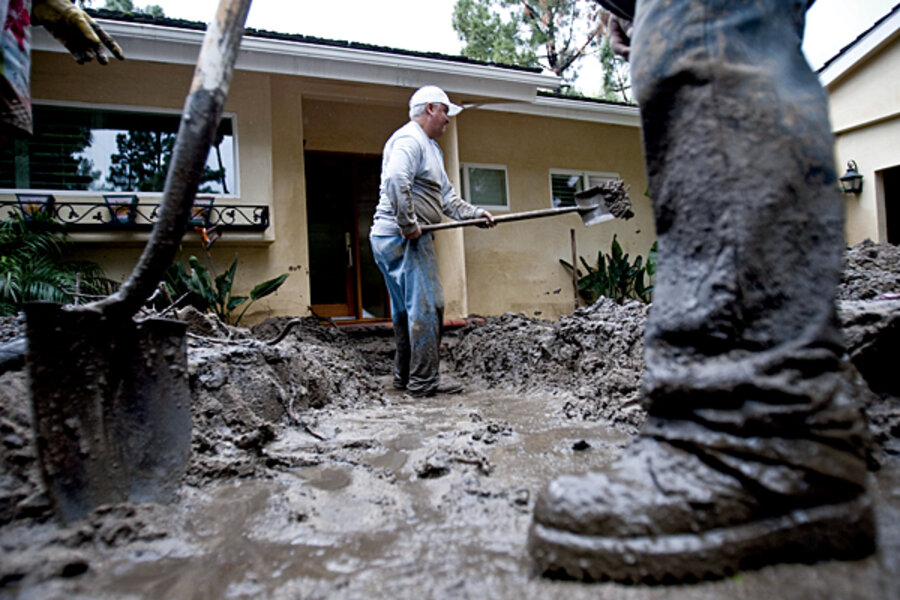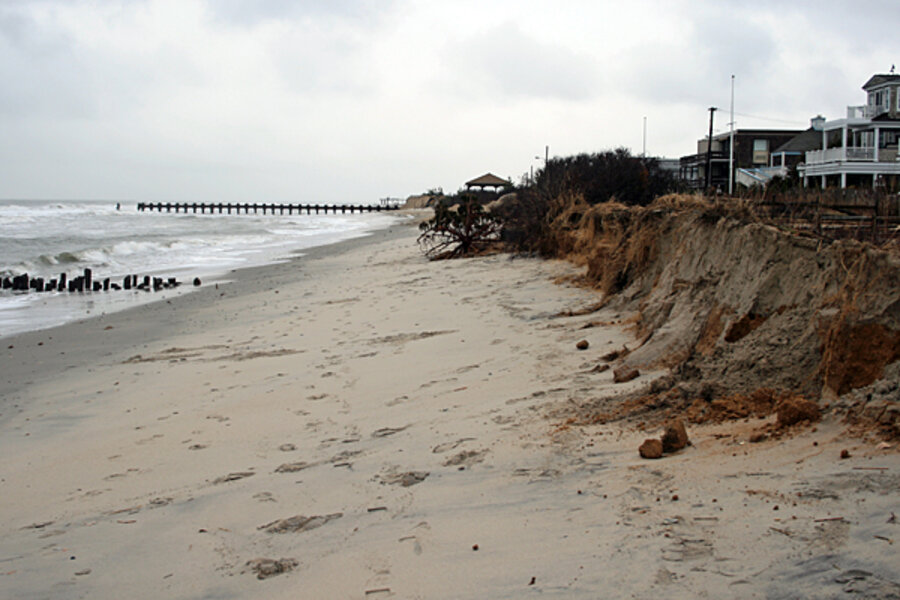Storm damage 2010: States ring up the cost
Loading...
| New York
Spring may be here, but winter left behind a hefty bill in many states, communities, and businesses.
• Iowa, which had a record snowfall this winter, is spending an extra $12 million to fill potholes and repair roads.
• Buffeted by fierce coastal storms, the beach community of Avalon, N.J., is forking out an extra $4.2 million for emergency beach replenishment. Tens of thousands of cubic feet of sand got sucked into the stormy Atlantic.
• Flooding in the upper Midwest prompted the Federal Emergency Management Agency (FEMA) to declare in mid-March an emergency in Minnesota, North Dakota, and South Dakota.
IN PICTURES: Springtime flooding in the US
To be sure, every spring requires repaving, cleanup from storm damage, and preparation for the summer. Still, with March coming to a close, the storms have hardly let up: Another coastal storm on Monday and Tuesday is expected to bring torrential rain – with the threat of flooding – to the mid-Atlantic and Northeast. The Pacific Northwest is also bracing for storms that could mean spring flooding, according to AccuWeather.com.
In many cases, the storms of the just-concluded winter entered another category. Six nor’easters barreled up the coast. The US capital shoveled 70 inches of snow, 50 of it in two weeks. California was hammered by a series of storms in January that left residents digging out from mudslides and floods. Six Golden State counties were declared eligible for federal emergency funds.
“It was a memorable winter because it affected so many people and so much of the economy,” says Scott Bernhardt, chief operating officer and a meteorologist at Planalytics, a weather intelligence service for business in Berwyn, Pa. “Last year we had a lot of snow, but it fell in places like the Dakotas and Montana. This year, it fell on the populated areas.”
This winter, 35 places in the United States have so far received federal disaster or emergency designation. The previous winter, there were 29 designations, and FEMA approved or promised to pay $891 million for relief.
In a new policy this past November, FEMA included major winter-storm sites as eligible for an emergency or major disaster declaration. Washington felt the effects of a disastrous snowstorm firsthand: In February, federal agencies in Washington shut down for 4-1/2 days at a cost of about $100 million per day in lost productivity.
This snow season was also expensive for those retailers who lost sales because consumers could not get to the malls. According to Mr. Bernhardt, the average retailer can make up only about two-thirds of lost sales. Once consumers get back on the road, they mainly concentrate on the basics and forgo impulse sales.
Still, the US economy is resilient, says economist Nigel Gault of IHS Global Insight in Lexington, Mass.
“The winter probably sapped the economy, but not in a major way,” he says, noting that construction projects were delayed, especially in the South.
“It’s not something that can slow down the economy’s momentum,” Mr. Gault says. “It is extremely resilient to even very big shocks like hurricanes.”
But no doubt some areas felt as if they had been hit by a hurricane.
As the storms rolled in this winter, they often took a big toll on beaches. In some coastal areas of California, the beaches have been decimated, says Kim Sterrett of the California Department of Boating and Waterways. “Sand levels are way down, the beaches are a lot narrower, and in certain areas the waves have stripped away all usable beach,” he says.
Typical of the areas affected is Imperial Beach, south of San Diego. During high tide, very little beach is left, says Greg Wade, community development director.
“If we continue to get a loss of sand, we could see significant property damage, infrastructure damage to city streets, and a lot of added maintenance cost,” says Mr. Wade, who notes that another cost could be the loss of tourism. Thirty percent of beach visitors are from out of town.
In 2003, the Army Corps of Engineers approved the expenditure of $50 million to $90 million over 50 years for beach replenishment at Imperial Beach. But Congress has yet to authorize the spending. “We go to lobby Congress every year, but we’ve been told unless our representative is staunchly behind it, our chances are not strong,” Wade says.
On the other side of the US, the Borough of Avalon has dug into its own pockets to the tune of $4.2 million to replace sand. It is in large part a matter of economic survival: On a summer day, 40,000 people visit the town, half of them spending time on the beach.
“We will have a beach this summer,” says Andrew Bednarek, the borough’s business administrator.
Around the country this winter, storms dumped huge amounts of moisture, some of it freezing and then thawing on roads. As a result, many communities need to do massive pothole repair.
“We’re even seeing damage in places like Alabama, where they have never had roadway damage like this before,” says Ken Kobetsky, a highway repair expert at the American Association of State Highway and Transportation Officials in Washington.
“There were some states that were in trouble [financially] even before the winter,” he says. “Even if emergency money is made available from Congress, getting it is not easy: Some states are still waiting for other emergency funds from last year.”






